FRIDAY, SEPTEMBER 18
■ Jupiter and Saturn this week continue shining nearly level in the south at dusk, as shown below. They tilt to the right as evening advances. They set in the southwest around midnight or 1 a.m.
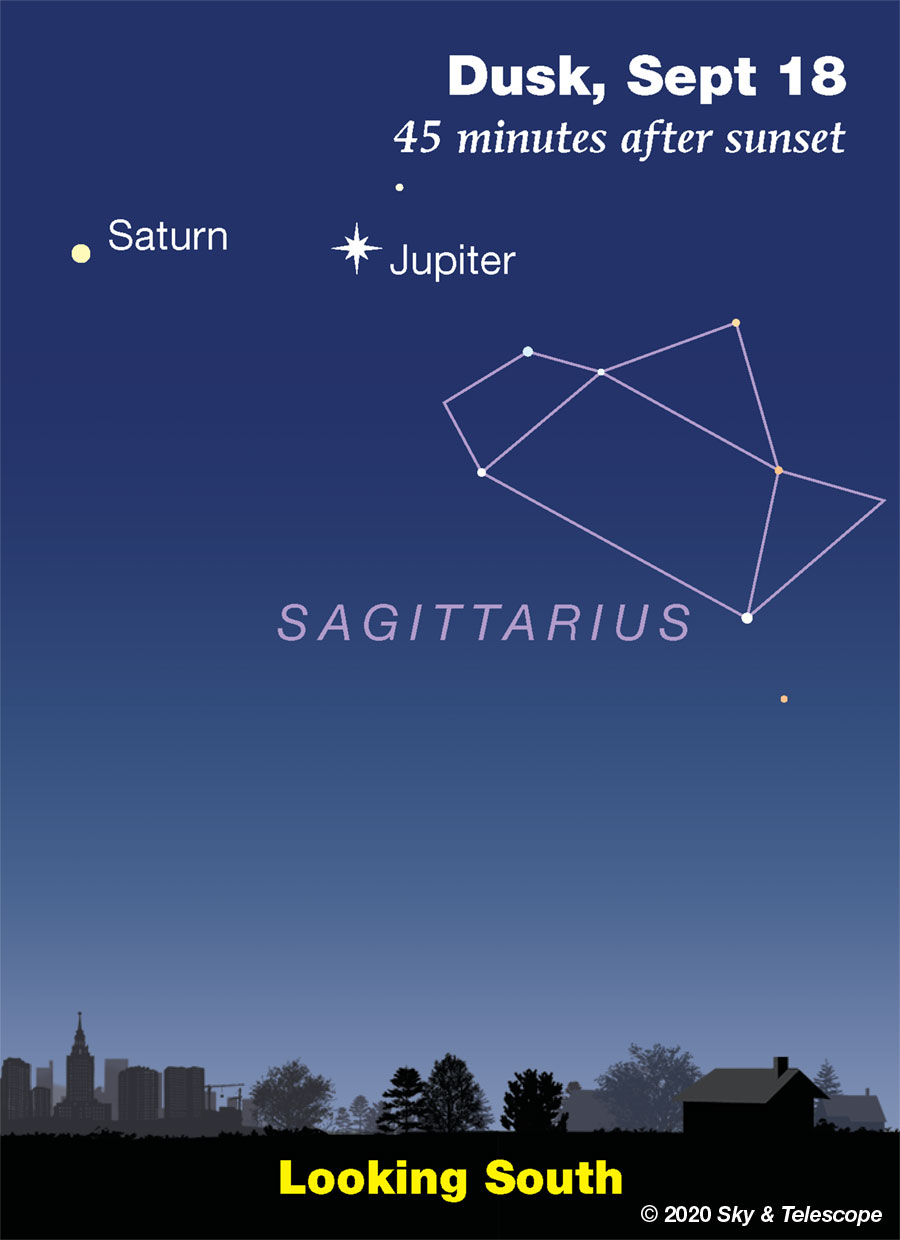
■ The season is changing; you can see it in the stars. We've reached the time of year when, just after nightfall, Cassiopeia has already climbed a little higher in the northeast than the Big Dipper has sunk in the northwest. Cassiopeia, a flattened W shape, marks the high northern sky in early evening during the chilly fall-winter half of the year. The Big Dipper takes over for the milder evenings of spring and summer.
Almost halfway between them stands Polaris, due north. It's currently a little above the midpoint between the two.
SATURDAY, SEPTEMBER 19
■ Arcturus, the "Spring Star," shines a little lower in the west after dark every week as summer turns to fall (the September equinox comes on Tuesday). From Arcturus, the narrow, kite-shaped pattern of Bootes extends a little more that two fists at arm's length to the upper right.
■ Moonless evenings will soon end for this month, but there's still time to catch the Milky Way under a dark sky. When Deneb crosses your zenith (two hours after Vega; around 9 or 10 p.m. now), the Milky Way does too — running straight up from the southwest horizon, and straight down to the northeast horizon.
SUNDAY, SEPTEMBER 20
■ How well do you really know the iconic Ring Nebula in Lyra? In the evening after moonset it's high overhead, in probably the darkest part of your sky. Explore its subtleties with Howard Banich's Going Deep column in the September Sky & Telescope, starting on page 58.
And explore the area of the outstretched hand of Andromeda, including the Blue Snowball nebula, a subtle galaxy, and several nice double stars, starting on page 62.
MONDAY, SEPTEMBER 21
■ Mercury and fainter Spica appear only 2/3° apart this evening, and 3/4° apart tomorrow evening, for North America. They're magnitudes 0 and +1, respectively, but they may be a challenge to spot even with binoculars since they're already very low above the west-southwest horizon in bright twilight just 15 or 20 minutes after sunset. And across much of North America, your low view may be further hindered by forest-fire smoke high in the atmosphere.
Mercury and Spica appear close enough together to fit easily into the view of a telescope at 50x or less. . . once you find them.
■ Moon occults double star this evening. The dark edge of the waxing crescent Moon eclipses the fine telescopic double star Beta Scorpii, magnitudes 2.6 and 4.5, for most of North America except the Northeast. Use a telescope to watch the pair disappear stepwise behind the Moon's earthlit edge, one after the other some seconds apart.
In the East the Moon will be very low. The mid-longitudes of the continent get the best view, in early-evening darkness with the Moon less low. Near the West Coast the star's disappearance happens in daylight, and its reappearance out from behind the Moon's bright limb occurs in twilight. Map and timetables for many cities.
TUESDAY, SEPTEMBER 22
■ Summer ends and fall begins (in the Northern Hemisphere) today at 9:31 a.m. EDT (13:31 UT). This is when the Sun crosses the equator heading south for the season. The Sun rises almost due east and sets almost due west, very close to 12 hours apart.
■ Coincidentally, around when summer turns to autumn every year, Deneb takes over from brighter Vega as the zenith star after nightfall (for skywatchers at mid-northern latitudes).
■ Around nightfall, look for Antares to the lower right of the crescent Moon. They're getting low in the southwest.
■ Jupiter's Great Red Spot should transit Jupiter's central meridian around 9:23 p.m. Eastern Daylight Time. Just 4 minutes later Jupiter's moon Io enters the eastern edge of the planet's disk, followed by Io's tiny black shadow at 10:42 p.m. EDT. Io and its shadow leave the other side of Jupiter's face at 11:43 p.m. and 12:58 a.m. EDT, respectively.
WEDNESDAY, SEPTEMBER 23
■ First-quarter Moon (exact at 9:55 p.m. EDT). The Moon shines in the south at dusk. To its left are Jupiter and Saturn, pointing at it.
THURSDAY, SEPTEMBER 24
■ Now the Moon, a day past first quarter, shines just a few degrees from Jupiter. Saturn looks on from their left, as shown below.
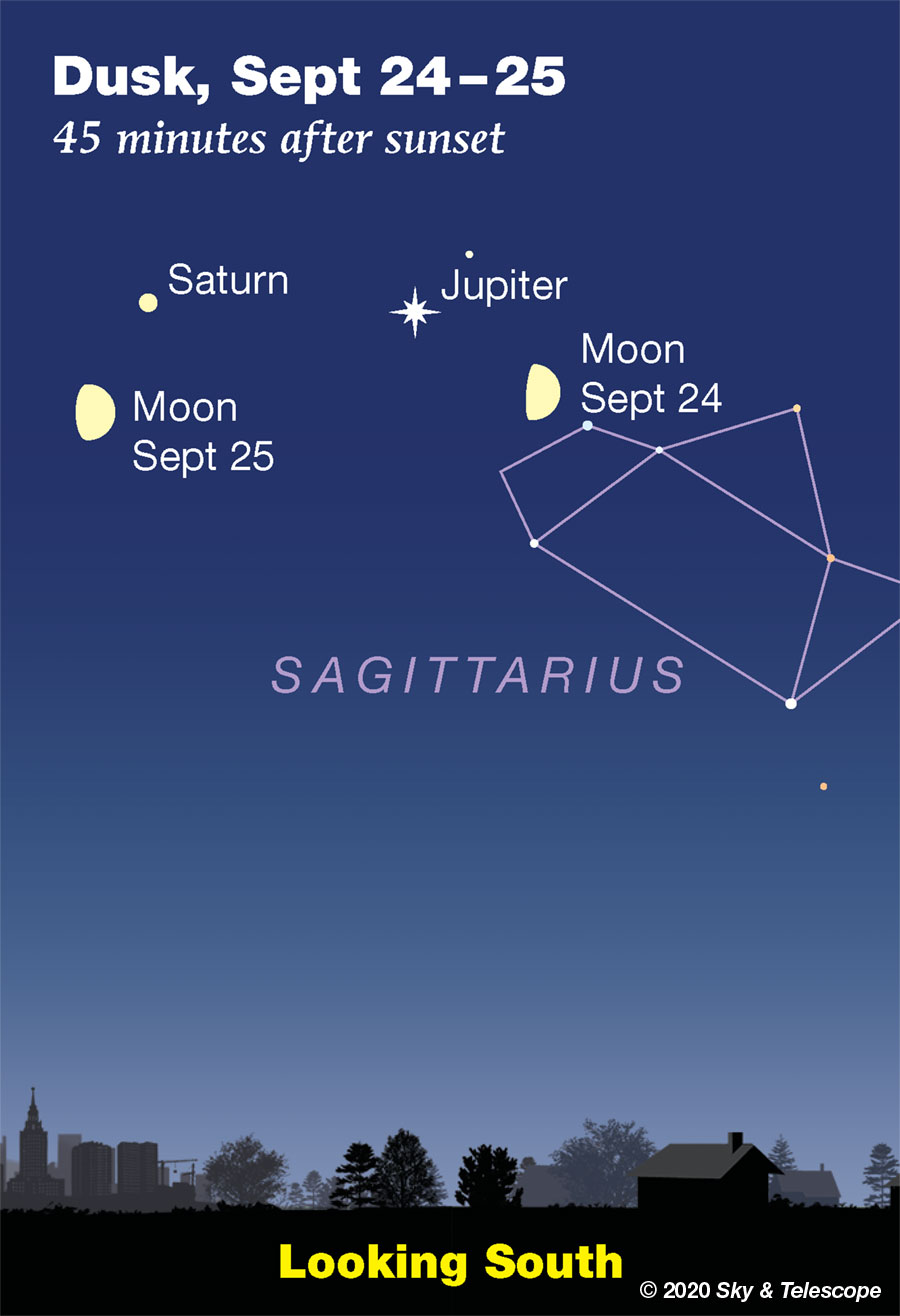
FRIDAY, SEPTEMBER 25
■ Now it's Saturn's turn to pair with the Moon, while Jupiter shines to their right, as shown above.
SATURDAY, SEPTEMBER 26
■ The waxing gibbous Moon shines in the south in mid-evening, inside the dim boat-shaped pattern of Capricornus. Off to its right are Saturn and then Jupiter.
Look a little farther to the Moon's lower left for Fomalhaut, the Autumn Star, slowly gaining altitude.
This Week's Planet Roundup
Mercury is having a very low, poor apparition deep in the sunset. At least it's fairly bright at magnitude –0.1 this week, so go ahead and try. Bring binoculars at least. About 15 minutes after sunset while twilight is still bright, start scanning for it just above the west-southwest horizon. Good luck.
Also in the vicinity is Spica, a magnitude fainter and twinklier. Spica and Mercury are ¾° or less from each other on September 21st and 22nd, when they'll easily fit together in a telescope's 40-power view.
Venus (magnitude –4.2, crossing from Cancer into Leo) rises in deep darkness two hours before dawn begins, in the east-northeast far below Pollux and Castor. By the time dawn gets under way, Venus shines prominently in the east, as shown below. Each morning it's drawing closer to much fainter Regulus.
Procyon shines about 30° (about three first at arm's length) to Venus's upper right. To the right or lower right of Procyon shines effulgent Sirius — the brightest star, but nowhere near a match for Venus.
In a telescope, Venus continues to shrink slowly into the distance; it's now 17 arcseconds in diameter. And it's becoming more gibbous, 67% sunlit now, as it rounds toward passing behind the Sun next winter.
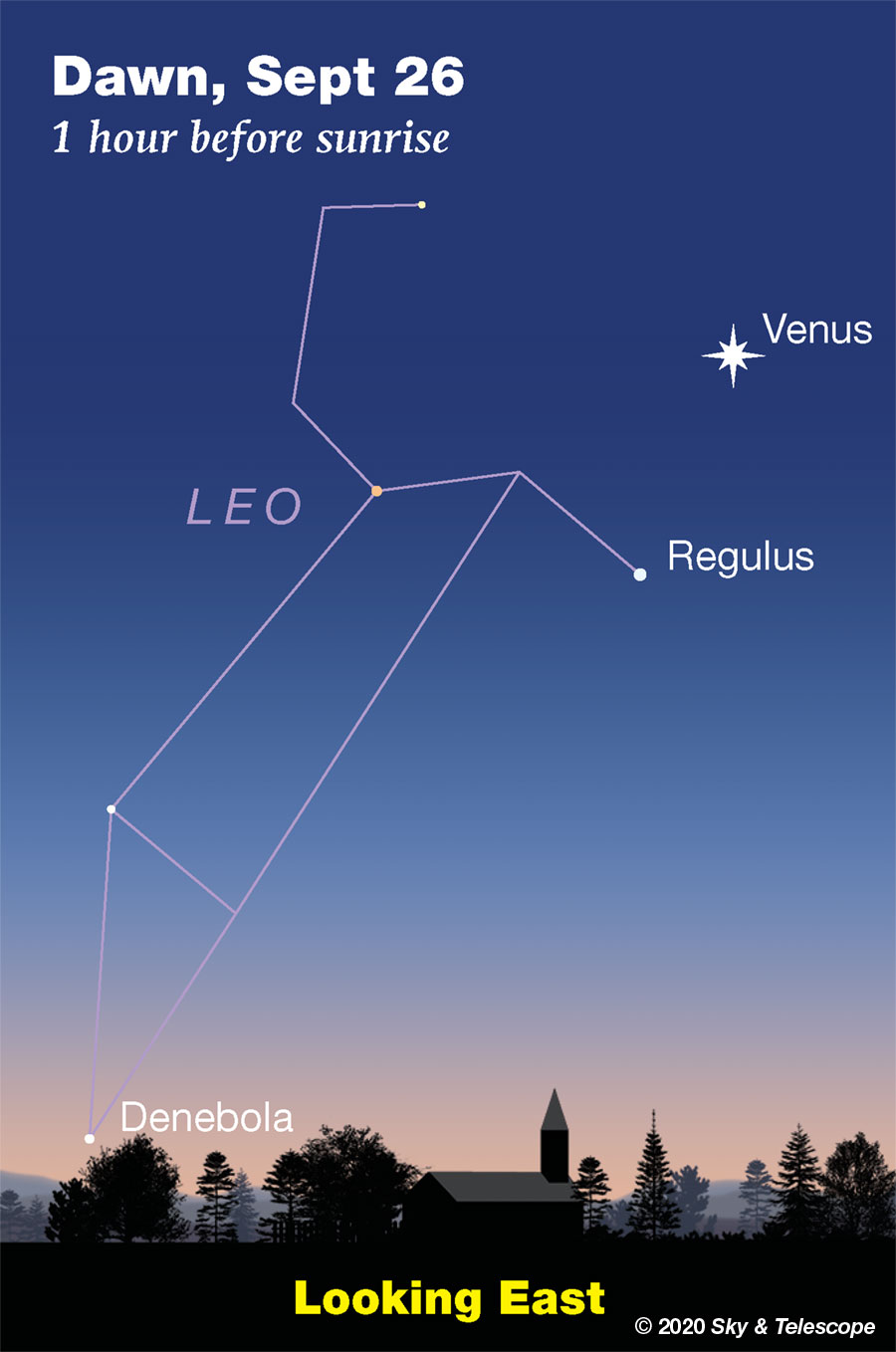
Mars shines ever bigger, brighter and closer as it approaches its October 13th opposition! It will pass closest by Earth on October 6th. And it's rising earlier too. This week it rises in the east in late twilight, shining bright orange at magnitude –2.3, almost Jupiter-bright. Mars climbs higher through the evening and stands at its highest and telescopic best around 2 or 3 a.m. daylight-saving time, beaming down from high in the south. It's near the dim (4th-magnitude) Knot of Pisces.
Mars is already 21 or 22 arcseconds in apparent diameter, as big for all practical purposes as it will be when passing closest by Earth (22.6 arcseconds). Look for its white South Polar Cap, now greatly shrunken as summer advances in Mars's southern hemisphere. There may or may not be any patches of cloud; this seems to be a clear season on Mars.
But Mars's dusky surface markings are the eternal attraction. To get a map of the side facing Earth at the date and time you'll observe, you can use our Mars Profiler. The map there is square; remember to mentally wrap it onto the side of a globe. (Features near the map's edges become very foreshortened.)
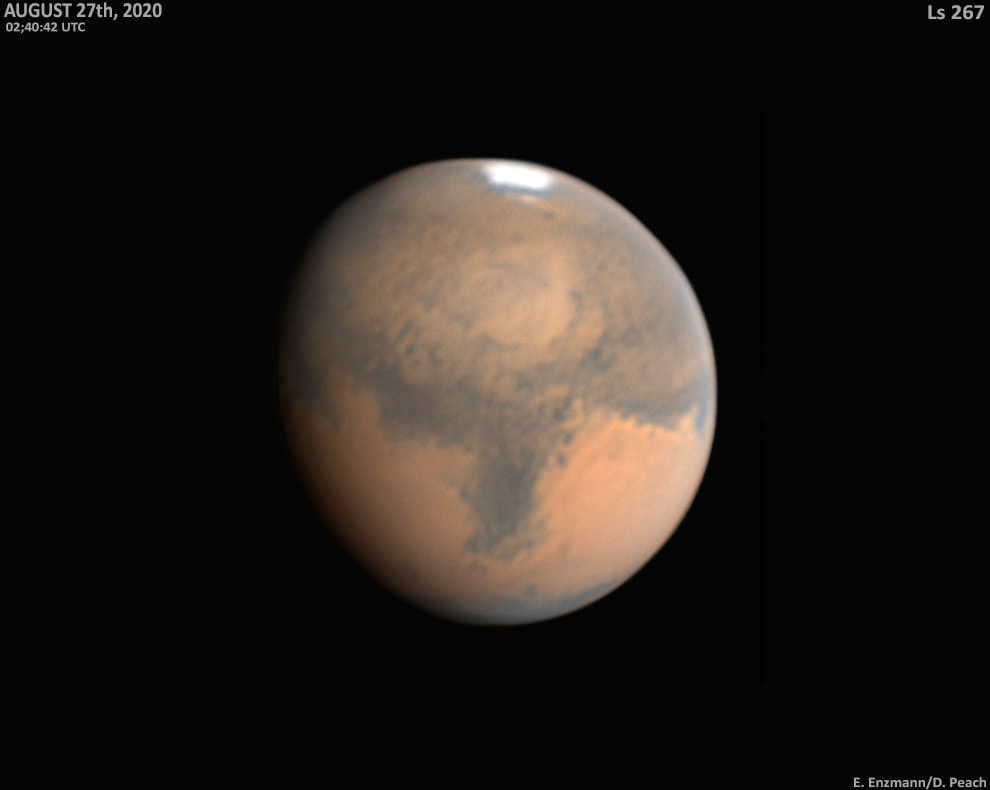
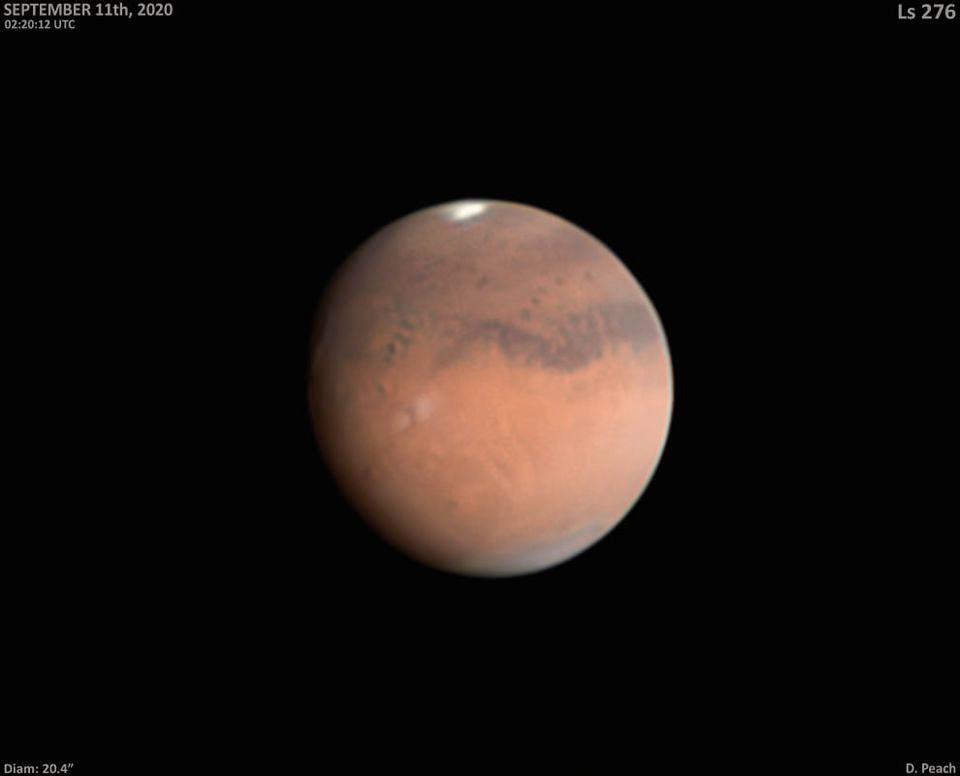
Jupiter and Saturn (magnitudes –2.4 and +0.4, respectively) shine in the south during dusk and early evening, as shown at the top of this page, then move to the southwest as evening grows late. Jupiter is the brightest. Saturn remains 8° to its left.
Very high above them shines Altair, magnitude +0.8. It's white-hot, 11 times as luminous as the Sun, and just 17 light-years away.
Much closer below Jupiter after dark is the handle of the Sagittarius Teapot. The brightest star of the handle (the upper-right one) is Sigma Sagittarii or Nunki, magnitude 2.0. It's an even larger, hotter blue-white star: 4.5 times the diameter of the Sun, 3300 times as luminous, and 230 light-years away.
Telescopically, there's a lot happening on Jupiter now; see Bob King's Stormy Times on Jupiter. And follow the interplay of Jupiter with its moons and their shadows, and find the transit times of Jupiter's Great Red Spot, in the Celestial Calendar section of the September Sky & Telescope, page 50.
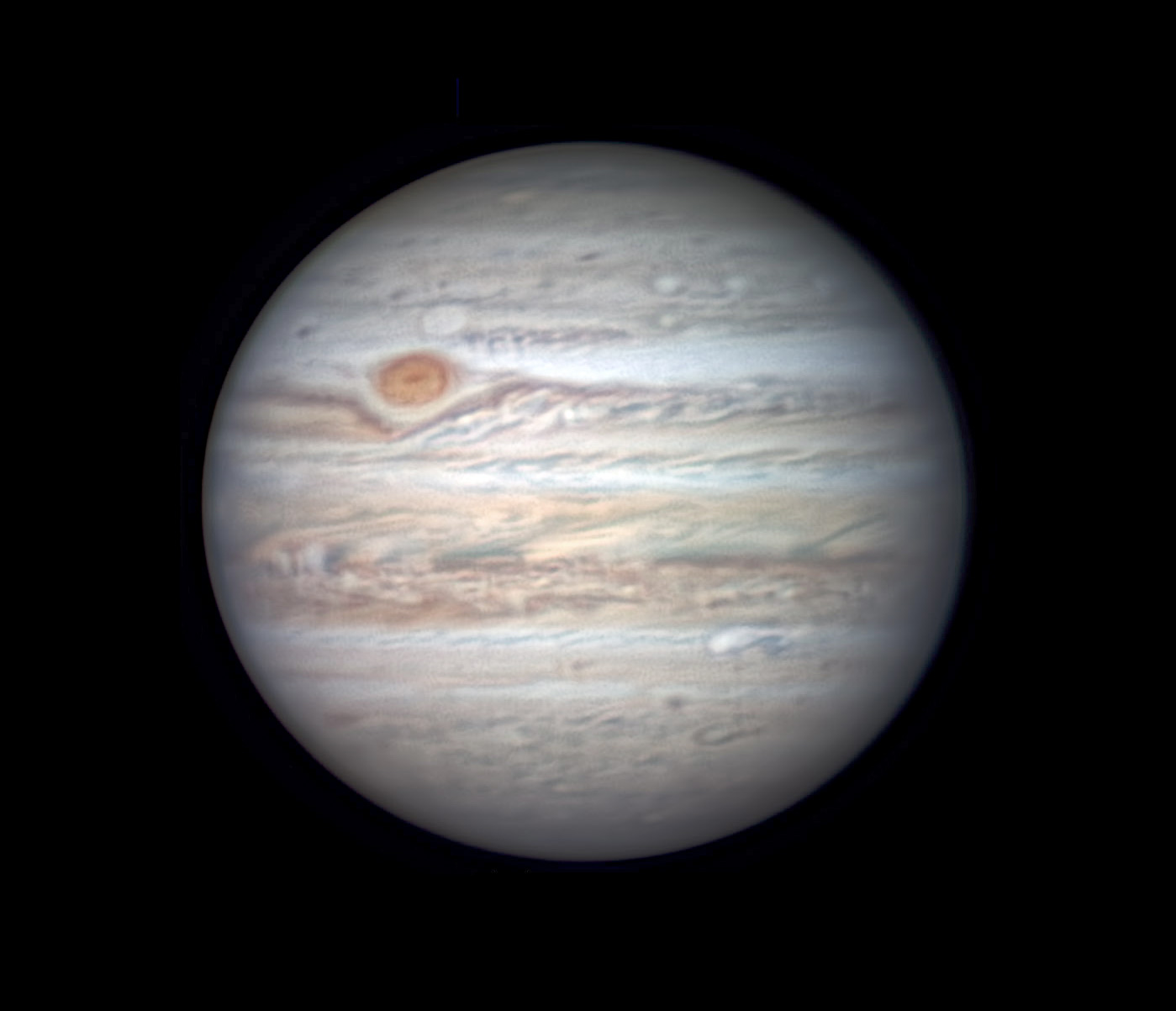
Skilled, well-equipped amateurs like Go can capture extraordinary planetary detail by judicious use of video-image stacking and processing. For comparison, here is a Hubble image of Jupiter taken two days later (with a NASA press release about it). Full-res version, with contrast and color contrast boosted way up. Go uses a 14-inch scope on his apartment balcony in Cebu City, Philippines. The Hubble is a fantastically sophisticated 92-inch telescope above the atmosphere!
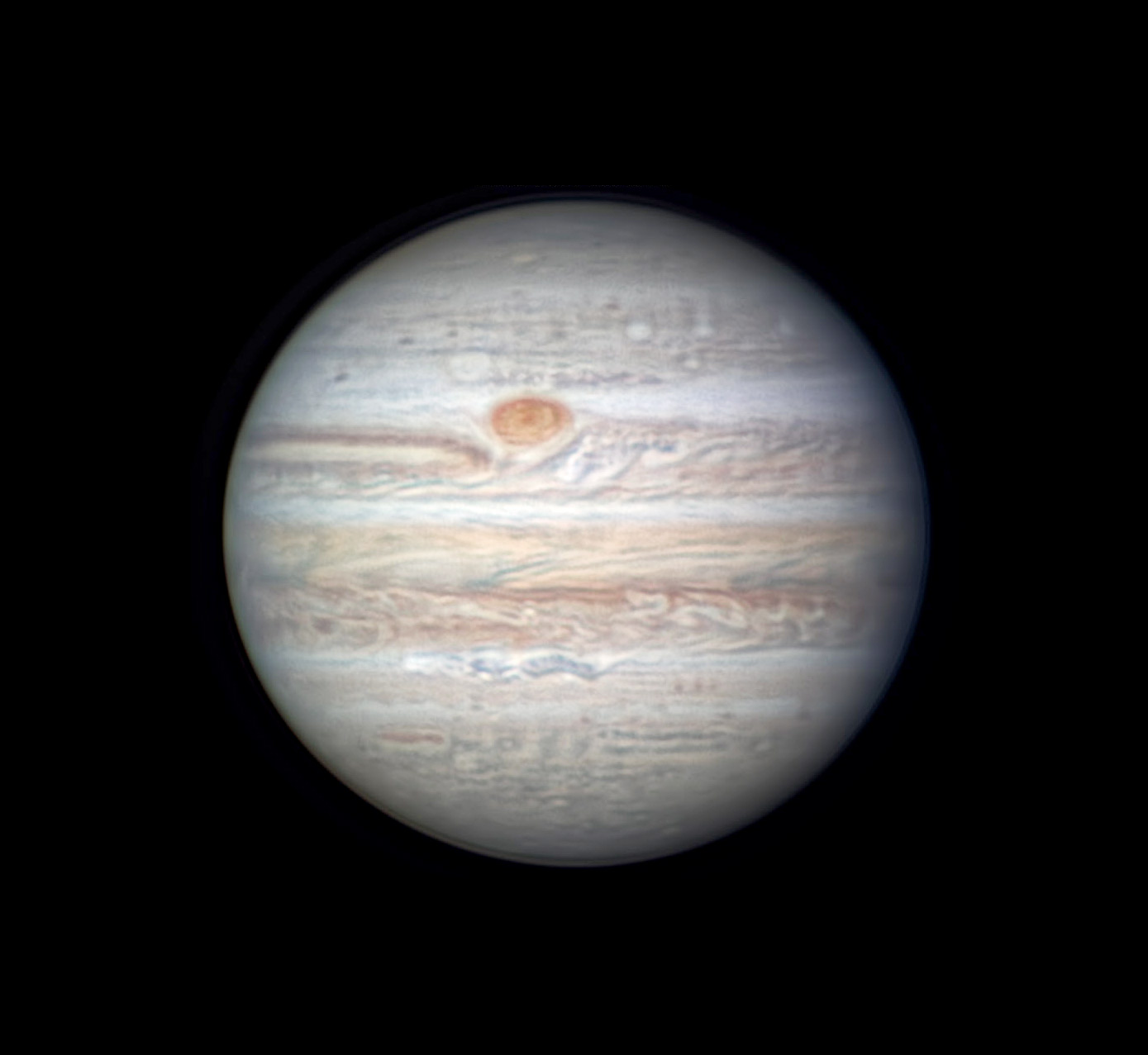
Uranus (magnitude 5.7, in Aries) is fairly well up in the east by 10 or 11 p.m. daylight-saving time, about 12° east of Mars.
Neptune (magnitude 7.8, in Aquarius) is higher in the south-southeast at that time. It was at opposition on September 11th. Finder charts for Uranus and Neptune.
All descriptions that relate to your horizon — including the words up, down, right, and left — are written for the world's mid-northern latitudes. Descriptions that also depend on longitude (mainly Moon positions) are for North America.
Eastern Daylight Time, EDT, is Universal Time (also known as UT, UTC, GMT, or Z time) minus 4 hours.
Want to become a better astronomer? Learn your way around the constellations. They're the key to locating everything fainter and deeper to hunt with binoculars or a telescope.
This is an outdoor nature hobby. For an easy-to-use constellation guide covering the whole evening sky, use the big monthly map in the center of each issue of Sky & Telescope, the essential magazine of astronomy.
Once you get a telescope, to put it to good use you'll need a detailed, large-scale sky atlas (set of charts). The basic standard is the Pocket Sky Atlas (in either the original or Jumbo Edition), which shows stars to magnitude 7.6.

Next up is the larger and deeper Sky Atlas 2000.0, plotting stars to magnitude 8.5; nearly three times as many. The next up, once you know your way around, are the even larger Interstellarum atlas (stars to magnitude 9.5) or Uranometria 2000.0 (stars to magnitude 9.75). And read how to use sky charts with a telescope.
You'll also want a good deep-sky guidebook, such as Sky Atlas 2000.0 Companion by Strong and Sinnott, or the bigger (and illustrated) Night Sky Observer's Guide by Kepple and Sanner.
Can a computerized telescope replace charts? Not for beginners, I don't think, and not on mounts and tripods that are less than top-quality mechanically, meaning heavy and expensive. And as Terence Dickinson and Alan Dyer say in their Backyard Astronomer's Guide, "A full appreciation of the universe cannot come without developing the skills to find things in the sky and understanding how the sky works. This knowledge comes only by spending time under the stars with star maps in hand."
![]() Audio sky tour. Out under the evening sky with your
Audio sky tour. Out under the evening sky with your
earbuds in place, listen to Kelly Beatty's monthly
podcast tour of the heavens above. It's free.
"The dangers of not thinking clearly are much greater now than ever before. It's not that there's something new in our way of thinking, it's that credulous and confused thinking can be much more lethal in ways it was never before."
— Carl Sagan, 1996
"Facts are stubborn things."
— John Adams, 1770
 8
8








Comments
Rod
September 19, 2020 at 10:47 am
mary beth, New Jersey Eclipse Fan, some great viewing here now! The weather here is Fall great now! Last night, I enjoyed some excellent telescope views of Mars at 129x to 200x using red, yellow, green, and blue filters. Blue is best for Venus The green filter, the south polar cap stood out sharply even though smaller size area now visible, same for yellow filter and the red filter really highlighted various dark surface features visible on Mars. I plan another telescope campaign tonight, using the Orion XT10i, 10-inch telescope. On 22-Sep at 0931 EDT, Fall arrives officially. First Quarter Moon is 24-Sep so the nights with clear skies like I am enjoying now, can be great planet and stargazing. It seems that the California wildfire smoke high up, is cleared out of the area so I am enjoying the views again ----Rod
You must be logged in to post a comment.
mary beth
September 19, 2020 at 8:02 pm
Happy almost autumn! So glad you’re getting some nice fall weather. Unfortunately I’m still in Texas and we are under a tropical storm warning here in Houston. Very depressing! I was looking forward to some crisp fall weather. Hopefully the storm will not be too bad, and we won’t lose power or have any damage. So I will have to stargaze vicariously through your posts. That’s interesting about the filter colors. I will keep you posted on the storm, hopefully I’ll have Internet and not have to post from my phone!
You must be logged in to post a comment.
Rod
September 20, 2020 at 9:24 am
mary beth, hopefully you will not have too much trouble with that tropical storm warning. Last night, I used my XT10i and enjoyed views of Mars from 86x to 216x. At 216x and no planetary filters used, Mars very bright in the view compared to my smaller, 90-mm telescope. Mars poked me in the eye but much more surface detail visible because the 10-inch gathers more light. I did use red and green filters at 86x and 154x views very nice surface details visible. I am enjoying some great fall weather here now in MD. Some STIHL chain saw work is coming too :)---Rod
You must be logged in to post a comment.
Tom Hoffelder
September 22, 2020 at 5:40 pm
The above would make for very nice private messaging on Facebook.
You must be logged in to post a comment.
New Jersey Eclipse Fan
September 23, 2020 at 7:45 pm
Maybe, but I’m not on Facebook and enjoy Rod’s & Mary Beth’s entries here, thank you very much.
You must be logged in to post a comment.
mary beth
September 24, 2020 at 12:07 am
Thank you NJEF! I’ve been reading this column since 2002, and I’ve learned so much from it. I usually don’t have much to add except a deep appreciation of the knowledge and experiences shared by others. Rod is always so gracious and he answers my questions in a way a non-scientific person can understand. Also I thoroughly enjoy his nature and weather reports, and your humorous musings. When you think about it we are all under the same tent, just with distance variations. Friends like you and Rod add a warmth and character to the hobby!
Because of this column I’m usually the only one in my neighborhood or even in groups of friends that is aware of what is going on in the night sky. I live fairly close to Johnson Space Center, and believe it or not a lot of the people in Mission Control and in other positions ask me questions about the Moon, stars and constellations. I always recommend this column to everyone who shows interest!
You must be logged in to post a comment.
New Jersey Eclipse Fan
September 24, 2020 at 9:23 pm
Anytime! I guess that makes me a humorous muser. I'll look for subsequent "Sky at a Glance" comments on the edition that comes out tomorrow.
You must be logged in to post a comment.
mary beth
September 24, 2020 at 9:56 pm
lol! Same bat time, same bat channel!!
You must be logged in to post a comment.
You must be logged in to post a comment.